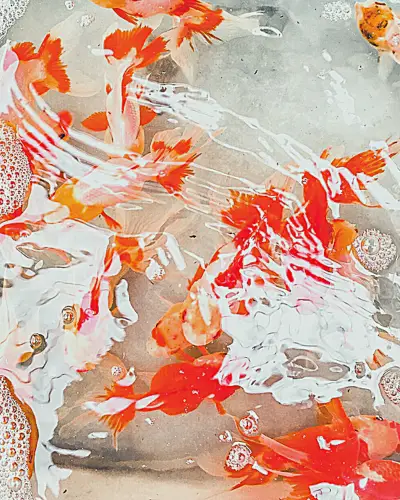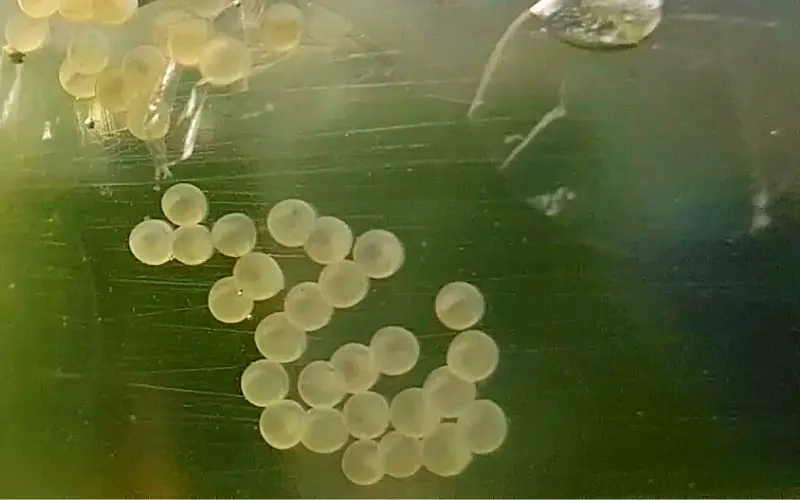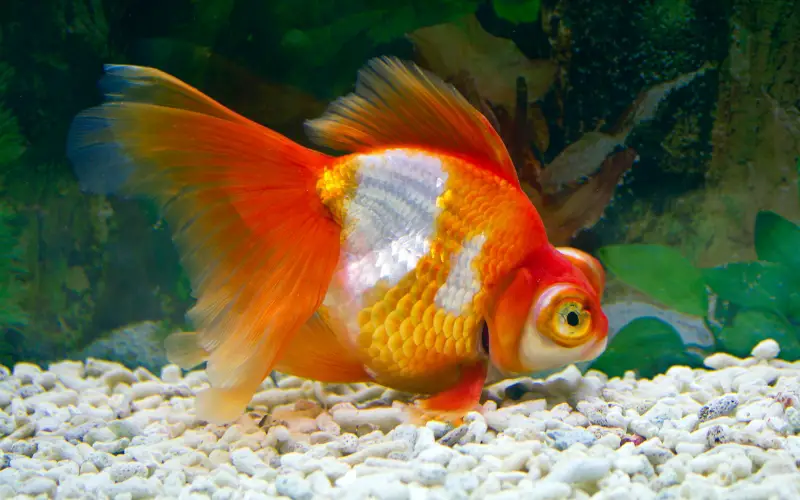Goldfish are fascinating creatures that have captured the interest of many pet enthusiasts. As an owner, it’s essential to understand their reproductive behavior to ensure their well-being. But do goldfish lay eggs or give live birth?
One common question is whether goldfish lay eggs or give live birth.
This article will debunk damaging myths surrounding goldfish reproduction and provide accurate information. So, let’s dive in!

Table of Contents
ToggleDo Goldfish Lay Eggs or Give Birth?
Do goldfish lay eggs or have live babies? Goldfish lay eggs rather than give birth to live young. This is a common misconception that myths and misinformation have perpetuated. This article will explore the truth about goldfish reproduction and debunk some damaging myths surrounding it.
When do Goldfish Lay Their Eggs?
Goldfish lay their eggs during the breeding season, typically in the spring or early summer. Female goldfish will develop eggs in their ovaries, and when they are ready to lay, they will release eggs along with a male goldfish’s sperm.

This will fertilize the eggs and start the development process. A batch full of eggs can consist of hundreds of eggs, depending on the size and age of the female goldfish. Goldfish will lay their eggs on plants, rocks, or the bottom of the tank or pond.
Once the eggs are laid, it is vital to provide appropriate care to ensure their survival. Providing a suitable environment with proper water conditions and food will increase the chances of the eggs hatching and the goldfish fry growing into healthy adults.
Where do Goldfish Lay Their Eggs?
Goldfish lay their eggs in a scattered, random manner. They do not have a particular spot where they like to lay their eggs. Their eggs might be found on the bottom of the aquarium, on the gravel, or the plants. It is possible to identify a goldfish egg as it is transparent, about 1-2 millimeters in size, and slightly sticky.

Since goldfish typically breed in the spring, this is when you’re most likely to find eggs in your aquarium. However, it’s important to note that not all goldfish will lay eggs.
Goldfish in captivity often require specific triggers to lay their eggs, such as a change in water temperature or a feeding regime. It is also essential to provide a suitable environment for the eggs to hatch and for the fry (baby fish) to grow.
Understanding the Reproductive Process of Goldfish
Goldfish reproduction follows a specific pattern that involves both egg-laying and external fertilization. Unlike mammals, goldfish are oviparous, meaning that fish release her eggs. Understanding this process is crucial for any goldfish owner.
It’s unfortunate but true. If you aim to breed as many goldfish as possible, avoiding keeping the eggs in the main tank is best. Like most other fish, goldfish can eat their own eggs and disrupt your breeding plans.
Goldfish Eggs: Appearance and Fertilization
Goldfish eggs are small, translucent, and spherical. They typically adhere to surfaces in clusters. After being laid by the female goldfish, the eggs need to be fertilized by the male goldfish. The male fish releases sperm into the tank water, fertilizing the eggs externally.
The Role of Male and Female Goldfish
In goldfish reproduction, both male and female fish play essential roles. The female releases the eggs, while the male goldfish releases sperm to fertilize them. This external fertilization process is a distinctive feature of goldfish reproduction.
The Ideal Environment for Goldfish Eggs
To ensure the successful development of goldfish eggs, it is essential to provide the ideal environment. A separate breeding tank with appropriate water conditions, temperature, and ample hiding spots is necessary. This promotes the well-being of both the eggs and the adult goldfish.
Hatching and Caring for Goldfish Fry
Goldfish eggs typically take around four to seven days to hatch. Once hatched, the newborn goldfish are called fry. They are fragile and require specific care, including a suitable diet and a separate rearing tank. Proper nutrition and optimal water conditions are crucial for their healthy growth.
Debunking Myths about Goldfish Reproduction
There are several myths surrounding goldfish reproduction that need to be debunked. Some people believe that goldfish can give live birth or that female goldfish become pregnant. However, these notions are inaccurate. Goldfish strictly follow an egg-laying reproductive process.
Identifying Pregnant Goldfish
Contrary to popular belief, it is not possible to determine if a goldfish is pregnant. Goldfish do not exhibit visible signs of pregnancy as mammals do. Instead, their reproductive activity is observed through the presence of eggs and spawning behaviors.
Ensuring a Healthy Reproductive Cycle for Goldfish
It is essential to provide them with a well-maintained aquarium environment. To ensure a healthy reproductive cycle for goldfish, This includes regular water changes, proper filtration, and monitoring of water parameters such as temperature and pH. A balanced diet and sufficient space for swimming and breeding activities also contribute to their reproductive health.
Steps to Breed Your Goldfish Successfully
If you are interested in breeding goldfish, following a few essential steps can increase your chances of success. Firstly, identify a compatible pair of goldfish, typically one male and one female. Create a separate breeding tank with suitable conditions and provide spawning stimuli.
Monitoring the breeding process closely and removing the adult fish once spawning is complete will help protect the eggs and ensure their survival.
Managing Goldfish Eggs in the Aquarium
Once the eggs are laid, managing them appropriately within the aquarium is crucial. Avoid disturbing the eggs or exposing them to direct light, which can harm their development.
Maintaining optimal water quality and temperature while keeping other fish species away from the eggs is essential. Providing gentle aeration and closely monitoring their progress will aid in successful hatching.
Common Challenges and How to Overcome Them
Breeding goldfish can pose particular challenges that require careful management. Some common challenges include infertile eggs, fungal infections, and predation by adult goldfish.
Ensuring a healthy diet, maintaining clean water conditions, and promptly removing any diseased or damaged eggs are crucial steps to overcome these issues. Creating a suitable breeding environment with adequate hiding spots can minimize predation risks.
Separating Adult Goldfish from the Eggs
Separating the adult goldfish from the breeding tank once spawning is complete is necessary. To protect the eggs from potential harm, adult goldfish, including the parents, may unintentionally goldfish eat their eggs. By transferring them to a separate tank, you can safeguard the developing eggs and provide them with a controlled environment for hatching.
Preventing Goldfish from Eating Their Eggs
In some cases, goldfish may exhibit cannibalistic behavior and eat their eggs. To prevent this, you can provide the goldfish with an alternate food source, such as brine shrimp, during the breeding process. Adding live plants or floating spawning mops in the breeding tank can create distractions and reduce the likelihood of the goldfish consuming their eggs.
The Development of Goldfish Eggs
The development of goldfish eggs is a fascinating process. As the eggs incubate, you may notice changes in their appearance. Initially, the eggs are transparent and have a small dark spot called the embryo. Over time, you can observe the embryo’s growth, and the eggs may become more opaque or develop a golden coloration.
How Many Eggs Do Goldfish Lay?
The number of eggs a goldfish lays can vary depending on the goldfish species and size. On average, a female goldfish can lay anywhere from a few hundred to a few thousand eggs during a single breeding season.
However, not all of these eggs will necessarily hatch into viable fry. Factors such as water quality, temperature, and genetics can all play a role in the success of goldfish breeding.
Can Goldfish Lay Eggs Without a Male?
Yes, goldfish laying eggs without a male in spawning. This is because goldfish are oviparous, which means they reproduce by laying eggs fertilized externally.
A female goldfish can still lay eggs without a male, but they will not be fertilized or develop into viable fry. However, if you want to breed goldfish and produce viable offspring, you will need both a male and a female to fertilize the eggs.
How to Tell the Difference between Fertilized and Unfertilized Goldfish Eggs?
Goldfish eggs are an essential factor in breeding these popular aquarium pets. However, it is important to differentiate between fertilized and unfertilized eggs. If you plan on breeding or have just been born goldfish, you will want to know this to take the necessary steps for the eggs to hatch.
Fertilized goldfish eggs will develop into embryos and eventually hatch into baby goldfish, while unfertilized eggs will not grow. It would be best to look closely at the eggs to tell the difference between fertilized and unfertilized eggs. Fertilized eggs will have small white dots in the center, while unfertilized eggs will be obvious.
As the eggs develop, they will become slightly more opaque, but you can still differentiate between healthy and unhealthy eggs. Healthy eggs will have transparent edges, while unhealthy ones look cloudy or discolored.
Once you have identified which eggs are fertilized and which are not, you can remove the unfertilized eggs to prevent them from contaminating the water and harming the healthy eggs.
Commonly Asked Questions about Going to lay eggs (FAQs)
How many eggs can a goldfish lay?
Goldfish can lay up to 1,000 eggs during a single spawning event.
How long does it take for goldfish eggs to hatch?
Goldfish eggs typically hatch around four to seven days, depending on the water temperature.
Can I tell if a goldfish eggs are fertilized?
Fertilized goldfish eggs will develop a small black dot called the embryo. You can observe this development as the eggs progress.
Should I remove the adult goldfish from the tank once the eggs are laid?
It is recommended to separate the adult goldfish from the tank to protect the eggs from being eaten or damaged.
How can I prevent goldfish from eating their eggs?
Disturbances like live plants or floating spawning mops can divert the goldfish’s attention and reduce their chances of consuming their eggs.
How do I create an ideal breeding environment for goldfish?
How do goldfish lay eggs? Ensure a separate breeding tank with suitable water conditions, temperature, and hiding spots. Maintaining water quality and a balanced diet for the goldfish is also essential.
Do goldfish lay eggs or give birth to live fry?
Goldfish lay eggs, and they do not give birth to live fry.
What do goldfish eggs look like?
Goldfish eggs are small and round, usually about 1-2mm in diameter. They are typically transparent or yellowish.
How long does it take for goldfish eggs to hatch?
The time it takes for goldfish eggs to hatch depends on the water temperature. At a temperature of 70-75°F, it can take up to 5-7 days for the eggs to hatch.
How do I tell if my goldfish is about to lay eggs?
A female goldfish preparing to lay eggs may appear rounder in shape, and her belly may look swollen. She may also become more active and swim more around the tank than usual.
How often do goldfish lay eggs?
Goldfish can lay eggs every two to three weeks during their breeding season, usually in spring.
Do male goldfish lay eggs?
No, only female goldfish are capable of laying eggs.
Can I keep the eggs in the same tank as the adult goldfish?
Adult goldfish will eat the eggs and fry, so removing the eggs and hatching them in a separate tank is recommended.
Will goldfish eat their own eggs?
Yes, adult goldfish will eat their eggs if given the chance.
How do I remove the eggs from the tank?
You can use a soft net or plastic tubing to gently scoop the eggs out of the tank and into the separate hatching tank.
What should I do with the fry once they hatch?
You can keep them in a separate hatching tank or move them to a larger one as they grow.
What Causes Goldfish to Lay Eggs?
Goldfish lay eggs in response to environmental cues such as water temperature, food availability, and daylight. Typically, goldfish will lay eggs in the spring and summer when these conditions are optimal for breeding.
Conclusion
So, do goldfish lay eggs or live birth? In conclusion, goldfish reproduce by laying eggs rather than giving live birth. Understanding the reproductive process of goldfish is crucial for their proper care and breeding. You can foster successful reproduction by providing the ideal environment, managing the eggs, and ensuring the health of the adult goldfish and the fry. Remember to separate the adult fish, prevent cannibalism, and maintain optimal conditions to maximize the chances of hatching healthy goldfish fry.
Understanding the reproductive behavior of goldfish and dispelling myths surrounding their reproduction is crucial for responsible goldfish ownership. By providing the right conditions and care, you can enjoy the beauty of watching goldfish eggs hatch and the growth of healthy fry. So, dive into the fascinating world of goldfish reproduction and create a thriving aquatic environment for your finned friends.
You might also like
- How Often Does Goldfish Lay Eggs & What does it Look Like?
- How Many Eggs Can Goldfish Lay at a Time? (You’ll Be Shocked)
- Goldfish Breeding Size: 5 Secrets to Bigger Broods (Solved)
- 5 Surefire Gold-fish Breeding Signs You Need to Know!
- Will Goldfish Breed in a Pond: 5 Positive Signs to Look For
- When Does Goldfish Mate in Ponds? (5 Signs to Look Out for)
- Can You Eat a Goldfish: 5 Shocking Reasons You Shouldn’t Do
- How Big Do Goldfish Need to Be to Breed: (A Detailed Answer)
- How do Goldfish Act When Laying Eggs: 5 Exciting Behaviors to Look For
- Goldfish Pregnant or Bloated: Don’t Miss These 7 Clear Signs!




